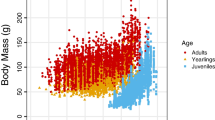Summary
Regular censuses were conducted at both a temperate alpine and a tropical lowland site to determine seasonal changes in the composition of hummingbird communities and the availability of their food. From these data we calculated the total daily energy demand by the hummingbirds (Daily Energy Expenditure; DEE) and the daily energy supply available from floral nectar (Daily Energy Production; DEP) for each community census. Despite differences in habitat type and hummingbird community structure between these two sites, the hummingbird populations were often at or near carrying capacity. On average, all of the daily nectar production was cropped by the birds. We suggest that the supply/demand economics of coevolved mutualisms favour the evolution of complete resource use.
Similar content being viewed by others
References
Baker HG, Baker I (1975) Studies of nectar constitution and pollinator-plant coevolution. In: LE Gillbert and PH Raven (eds), Coevolution of animals and plants. Univ. Texas Press Austin. pp 100–140
Boyden TC (1978) Territorial defense against hummingbirds and insects by tropical hummingbirds. Condor 80:216–221
Cody ML (1968) Interspecific territoriality among hummingbird species. Condor 70:270–271
DesGranges J-L (1978) Organization of a tropical nectar-feeding bird guild in a variable environment. Living Bird 17:199–236
Dethier VG, MacArthur RH (1964) A field's capacity to support a butterfly population. Nature 201:728–729
Feinsinger P (1976) Organization of a tropical guild of nectarivorous birds. Ecol Monogr 46:257–291
Feinsinger P (1980) Asynchronous migration patterns and the coexistence of tropical hummingbirds. In: ES Morton and A Keast (eds), Migrant Birds in the Neotropics: Ecology, Behavior, Distribution, and Conservation. Smithsonian Inst Press Washington. pp 411–419
Feinsinger P, Swarm LA (1978) How common are ant-repellent nectars? Biotropica 10:238–239
Gass CL (1979) Territory regulation, tenure, and migration in rufous hummingbirds. Can J Zool 57:914–923
Gass CL, Angehr G, Centa J (1976) Regulation of food supply by feeding territoriality in the rufous hummingbird. Can J Zool 54:2046–2054
Gass CL, Montgomerie RD (1981) Hummingbird foraging behavior: Decision-making and energy regulation. In: Foraging Behavior: Ecological, Ethological, and Psychological Approaches. A Kamil, TD Sargent (eds), pp 159–194 Garland STPM Press New York
Grant PR (1972) Interspecific competition among rodents. Ann Rev Ecol Syst 3:79–106
Grant PR (1978) Dispersal in relation to carrying capacity. Proc Natl Acad Sci (USA) 75:2854–2858
Hainsworth FR (1977) Foraging efficiency and parental care in Colibri coruscans. Condor 79:69–75
Hainsworth FR (1978) Feeding: A model of costs and benefits in energy regulation. Amer Zool 18:701–714
Hairston NG, Smith FE, Slobodkin LB (1960) Community structure, population control, and competition. Amer Natur 94:421–425
King JR (1974) Seasonal allocation of time and energy resources in birds. In: RA Paynter (ed), Avian Energetics, Publ Nuttal Ornithol Club No 15, pp 4–85
Krebs CJ (1978) Ecology: The Experimental Analysis of Distribution and Abundance. 2nd edition. Harper and Row New York
Lack D (1966) Population Studies of Birds. Oxford Univ Press, Oxford
Montgomerie RD (1979) The Energetics of Foraging and Competition in some Mexican Hummingbirds. Ph D thesis, McGill Univ
Montgomerie RD, Redsell CA (1980) A nesting hummingbird feeding solely on arthropods. Condor 82:483–484
Pearson OP (1954) The daily energy requirements of a wild Anna hummingbird. Condor 56:317–322
Pimentel D, Levin SA, Soans AB (1975) On the evolution of energy balance in some exploiter-victim systems. Ecology 56:381–390
Pitelka FA (1942) Territoriality and related problems in North American hummingbirds. Condor 44:189–204
Primack RB, Howe HF (1975) Interference competition between a hummingbird Amazilia tzacatl and Skipper Butterflies (Hesperiidae). Biotropica 7:55–58
Ricker WE (1973) Linear regressions in fishery research. J Fish Res Bd Can 30:409–434
Sinclair ARE (1975) The resource limitation of trophic levels in tropical grassland ecosystems. J Anim Ecol 44:497–520
Slobodkin LB, Smith FE, Hairston NG (1967) Regulation in terrestrial ecosystems, and the implied balance of nature. Amer Natur 101:109–124
Watson A (ed) (1970) Animal populations in relation to their food resources. Blackwells London
Wiens JA (1977) On competition and variable environments. Amer Sci 65:590–597
Wolf LL, Hainsworth FR (1978) Energy: Expenditures and Intakes. In: Chemical Zoology, Vol 10 Aves M Florkin, BT Scheer, A Brush (eds), Academic Press New York, pp 307–358
Wolf LL, Stiles FG, Hainsworth FR (1976) Ecological organization of a tropical highland hummingbird community. J Anim Ecol 45:349–379
Author information
Authors and Affiliations
Rights and permissions
About this article
Cite this article
Montgomerie, R.D., Gass, C.L. Energy limitation of hummingbird populations in tropical and temperate communities. Oecologia 50, 162–165 (1981). https://doi.org/10.1007/BF00348031
Received:
Issue Date:
DOI: https://doi.org/10.1007/BF00348031




